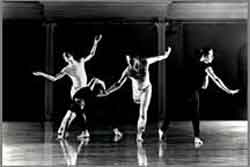Watching a dance can resemble strolling down a street staring at pedestrians or peeking into windows. A stroller never knows what he or she will see or what those sights will mean. They can be fascinating, nonetheless. So, too, there are times when a dance is poignant, eerie, anguished or ecstatic and the onlooker can't say precisely why. Take the struggles shown in "La Stravaganza," Angelin Preljocaj's contribution to the Diamond Project, the New York City Ballet's spring series of premieres. Or take the melancholy of Trisha Brown's new "Canto/Pianto," which the Trisha Brown Company presented at this summer's American Dance Festival, or the eccentric dithering of "Almost Rapture and Other Dance Surprises," the collaboratively choreographed suite that Paul Langland and Brendan McCall offered at St. Mark's Church. It's easy to praise these pieces for their inventiveness, harder to explicate them.
What helped make "Almost Rapture and Other Dance Surprises" unusual was the way its choreographic phrases seldom ended in themanner in which they began. Jittery tappings of fingers and toes were interrupted by bored yawns. Dancers holding solemn poses made gurgling noises that made the poses silly rather than grand. In a solo, a woman went from serenity to apparent panic. But a fleeting, wicked grin suggested that this character was only feigning her loss of control. Mr. Langland and Mr. McCall reveled in surprises.
|
 |
|
The capacity of choreography to be simultaneously forceful in impact and vague in meaning is one reason dance is a gloriouslymysterious art.
It's also an art that resembles everyday life, an art that can be compared with strolling and peeking. Surely everyone has watched people gesticulate vehemently in conversation. What they say may be unheard and therefore incomprehensible, yet one keeps staring, mesmerized by their animation and intensity. The comings and goings of people in the street - their huddlings together, their brisk or languid departuress, their changes of direction and sense of determination or uncertainty - can also command attention. And should one peep into windows, one might see everything from staid gatherings to violent quarrels or erotic revelry.
Purposeful movement holds attention even when its purpose is unknown. States of tension or relaxation are rich in implications. When dancegoers complained that his ballets had no stories, George Balanchine like to reply that two people on a stage were a story in themselves. So they are, and where they are placed on that stage can matter as much as how they move.
Did Mr. Preljocaj's Dutch characters symbolize stern authority figures? Did Ms. Brown's upraised woman represent Eurydice departing the underworld? It's impossible to say for sure, just as it's impossible to say why Mr. Langland and Mr. McCall juxtaposed wild runs and whirling arms with tiny finger wigglings and blinks of othe eye. But the dancers in these pieces were so intent on doing what they did that one couldn't stop watching them. It was like peeping into other people's lives. |
|